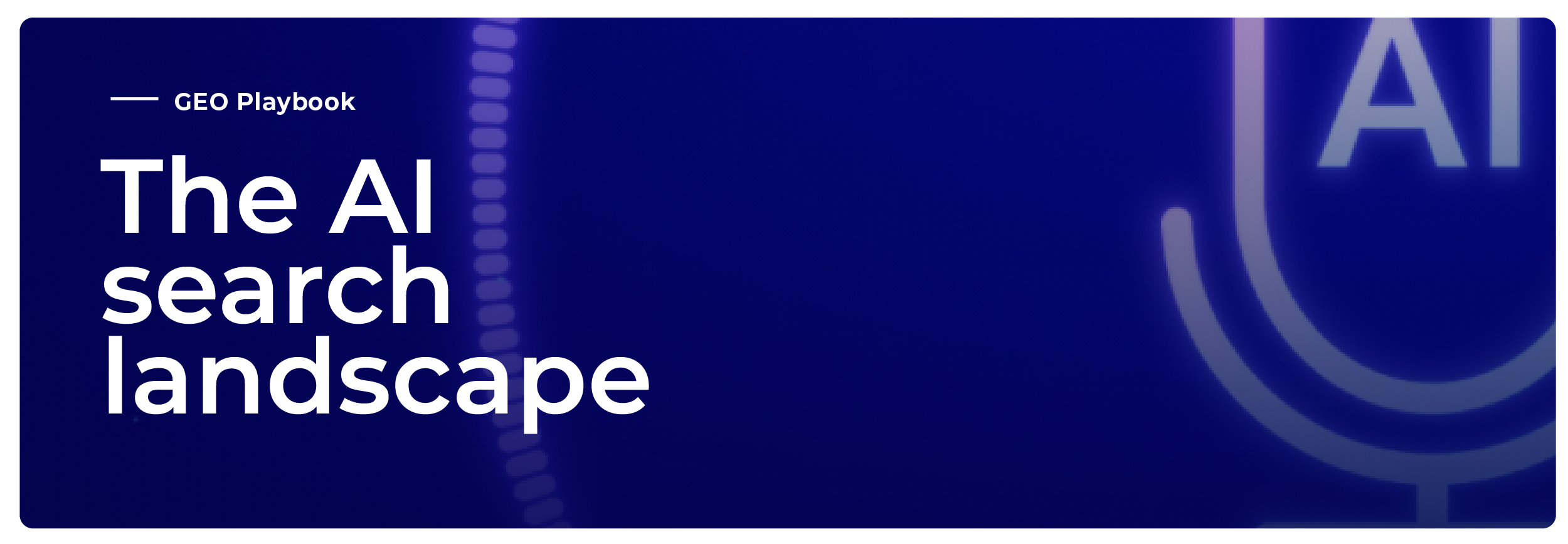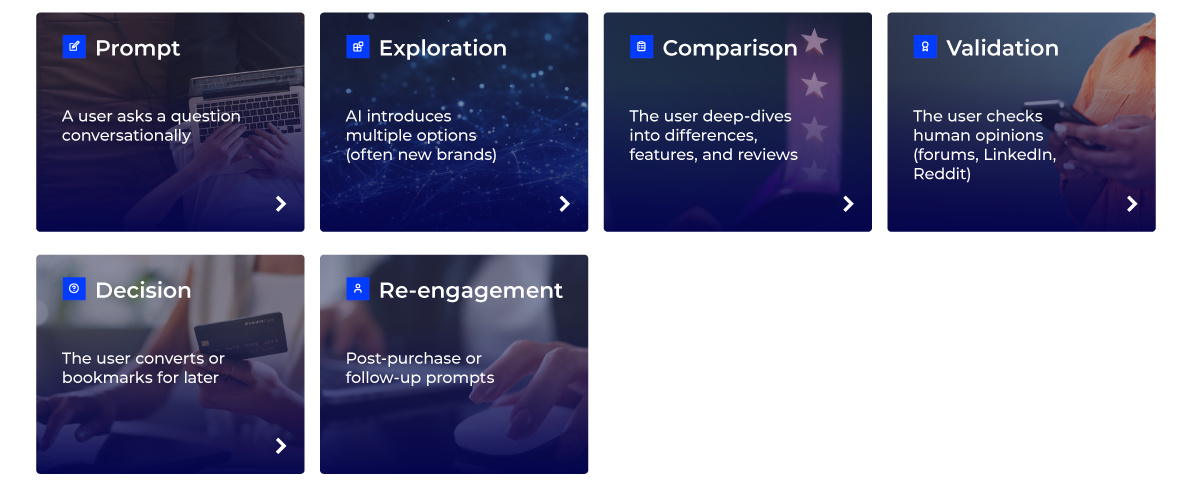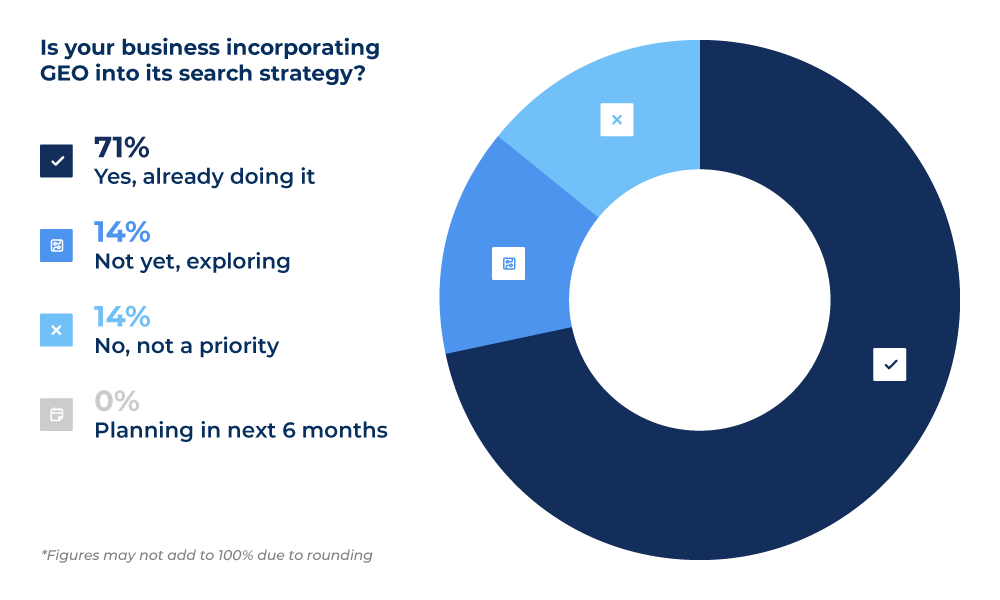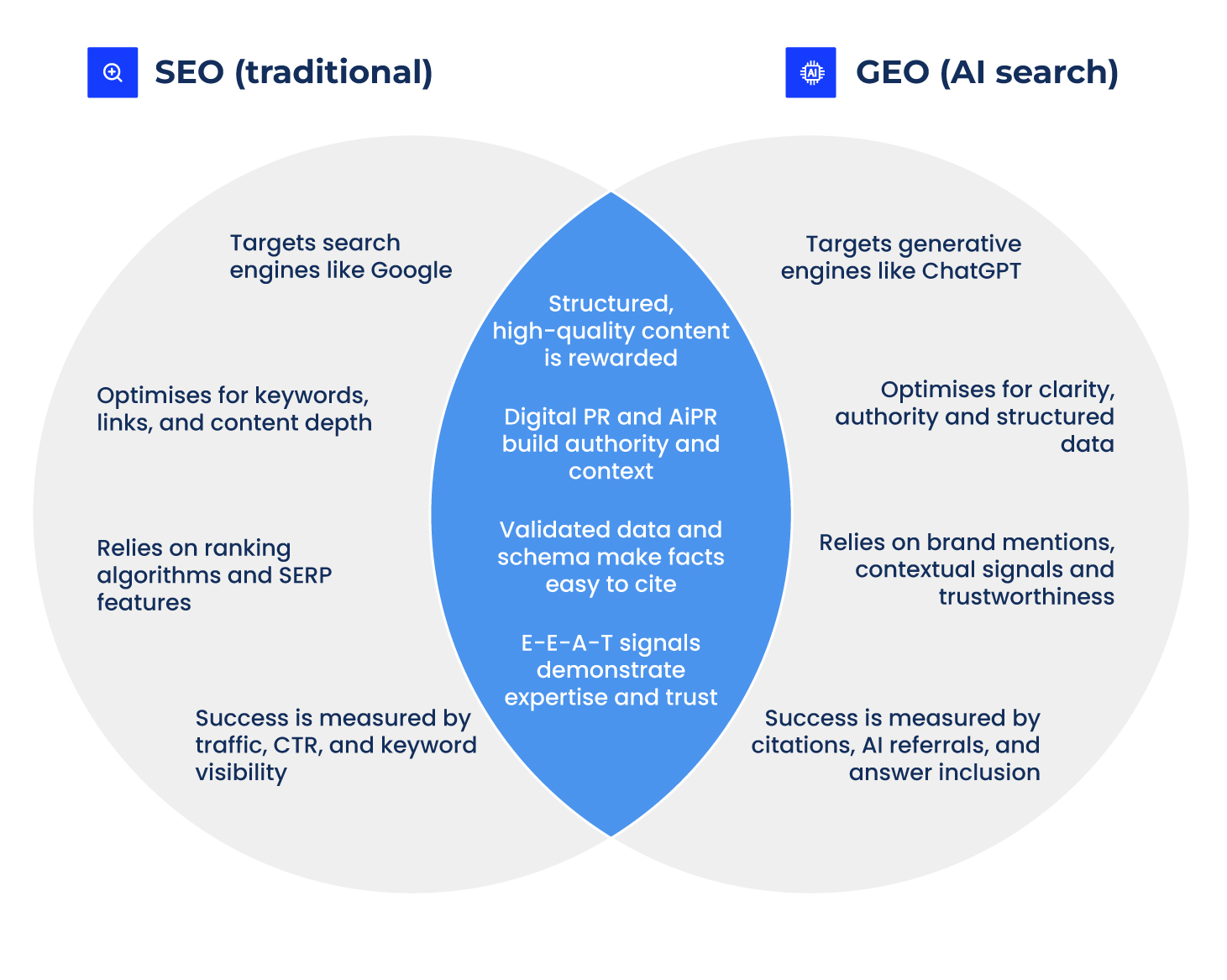- The new search landscape
- The main AI players and how they surface brands
- The rise of GEO
- How AI reads and reuses your content
- What visibility looks like now
- What this means for brands in 2026
- How to get cited in AI answers
- Why GEO must sit inside your search plan
- A practical framework to start
- Where next?
- Back to theGEO playbookhomepage
_____ THE GEO PLAYBOOK
The AI search landscape and what it means for brands

Search is changing faster than ever. Old SEO tactics will no longer get you visibility in AI search. As a leading GEO agency, we've seen firsthand how this shift has changed the rules of visibility.
For years, visibility in search meant fighting for the top 10 links in the search engine results page (SERP). Ranking on page one was enough to be seen, but that's no longer the case. Users can now see instant, direct answers from AI assistants (like ChatGPT) and Google’s AI Overviews.
These tools use large language models (LLMs) to summarise and interpret information from across the web, often reducing the need to click through to the source. The challenge for brands is no longer ranking, but being referenced by AI.
Generative Engine Optimisation (GEO) helps ensure your brand, data, and insights appear within those AI-generated answers. This chapter sets the scene for how generative search is reshaping discovery, and what this shift means for marketing leaders.
The new search landscape
Traditional SEO relied on visibility in the SERPs - if you ranked on page one, you were seen. But search behaviour has evolved.
AI tools now answer questions conversationally. A user might ask, “Which UK universities produce the highest-earning graduates?” and get a summarised response with data, analysis, and brand citations - often without a single click.
In our latest research, we found that 82% of marketers said they’re using AI to simplify manual tasks and speed up decision-making. This acceleration mirrors how users now expect faster, direct answers - and why visibility increasingly depends on being cited within those responses.
82% of marketers said they’re using AI to simplify manual tasks and speed up decision-making.
Search journeys are now longer, more complex, and increasingly brand-agnostic. People rely on generative tools to compare, evaluate, and decide, meaning brands must compete for inclusion within AI answers, not just rankings.
 Traditional search journey
Traditional search journey


AI-influenced search journey

The main AI players and how they surface brands
Each platform has its own way of sourcing and crediting information, which determines how brands appear.
The table below summarises how each major platform sources and displays information.
| Platform | Users (approx.) | Share of market | Data source | Citation style | Primary use case | Visibility focus |
|---|---|---|---|---|---|---|
| Google AI Overviews | Billions (integrated in Search) | ~70% | Live Google index | Linked snippets | Informational queries, general search |
|
| ChatGPT (OpenAI) | 180 million+ monthly users | ~10% | Training data and live web (via browsing mode) | Mentions or citations | Writing, research, brainstorming |
|
| Bing Copilot | 100 million+ monthly users | ~7% | Bing Search and web | Linked cards | Search, productivity integration |
|
| Perplexity AI | 10 million+ monthly users | ~5% | Active web crawl + verified sources | Always linked | Research, professional knowledge queries |
|
| Claude (Anthropic) | Not published, but rapidly growing | ~3% | Licensed datasets + web | Mentions only | Analytical writing, coding, creative tasks |
|
| DeepSeek / Others | Emerging | <5% combined | Mixed public data | Mentions only | Coding, data tasks |
|
Although usage patterns vary, these platforms share one thing - they reward clarity, credibility, and freshness.
For brands, that means structuring content to be easily quoted, maintaining factual accuracy, and ensuring data remains current. The stronger your clarity and authority signals, the more likely your brand will be cited across multiple AI platforms.
The rise of GEO
GEO (Generative Engine Optimisation) is the process of making your content discoverable, understandable, and trustworthy to AI models.
Unlike traditional SEO, GEO focuses on citations rather than rankings. The goal is to make your content the most logical and reliable source for AI to reference when generating answers.
For instance, when someone searches for “Who are the top fertility experts in the UK?”, traditional SEO strategies focus on getting your page to rank. GEO aims for your brand to be cited in the AI-generated answer - even if users never click through.
GEO is not a replacement for SEO, it's an evolution of it.
It brings together technical SEO, Digital PR, and data-led content (like our Hyper Relevancy Projects) to build trust signals that resonate with both users and AI systems.
How AI reads and reuses your content
At Reboot Online, we’ve run controlled GEO experiments to test how structured content and citations influence AI-generated visibility - and now we're sharing what works.
From our experimentation, one thing is clear - AI systems don’t crawl and rank pages the same way traditional search engines do.
Instead, they extract snippets of page content that they can easily repurpose in their answers. These include:
 Clear definitions
Clear definitions
 Short explanations
Short explanations
 Lists
Lists
 Tables and data points
Tables and data points
 Quotes
Quotes
Pages that use structured formatting and concise statements are easier for AI to lift from. For example:
“Unoccupied property insurance covers homes left empty for 30 days or more”.
A clear, factual line like this can be cited directly by an AI tool. In contrast, dense paragraphs with vague phrasing are often ignored.
Freshness is also important. Models like Gemini and Perplexity weigh newer, verifiable information more heavily than outdated data. This means quarterly updates to statistics and content can directly improve your brand’s chances of being cited.
On top of this, consistency matters too. When your brand is described in the same way across your site and external coverage, AI learns to associate that phrasing with your expertise.
Over time, those brand descriptors (like “UK fertility experts” or “unoccupied home insurance specialists”) become associations that influence LLMs and AI answers.
Read more about this in our marketer’s guide to generative AI.
Read more
What visibility looks like now
In AI search in 2026, visibility means being present inside an answer, and not ranking on the first page. With tools like Google AI Overviews now the go-to for users, the number of traditional organic clicks continues to fall.
Ahrefs’ 2025 analyses show AI Overviews reduce position one click-through rates by 34.5% and reach more than 1.5 billion users monthly. This explains why being featured in AI answers now matters more than ‘traditional’ SEO rankings.
This data highlights how search behaviour has evolved. Users expect immediate, conversational responses, and brands that do not adapt their visibility strategies risk being excluded from these AI-generated results altogether.
The patterns that define visibility
Reduced organic traffic - even if you still ‘rank’, fewer users reach your site
Concentrated exposure - a smaller pool of brands is referenced repeatedly, becoming trusted defaults
Longer-term brand imprint - once a model associates your name with a topic, it continues using that connection until retrained
While rankings fluctuate daily, AI associations are essential. Once a model learns that your brand is a credible authority on a given subject, that connection sticks - even when your page isn’t the newest or most linked.
For CMOs, this changes how performance is measured. Visibility within AI-generated answers is now a key signal of reputation and reach, even if referral traffic remains modest.
Read more about this in our guide to tracking AI visibility.
Read more
What this means for brands in 2026
By 2026, AI integration will be standard across all major search platforms. Brands that have invested early in clarity, structure, and authority will be the ones consistently cited in generative results.
For marketers, this means rethinking reporting frameworks. SEO dashboards must evolve to include:
 Citations and mentions - tracking brand presence inside AI results.
Citations and mentions - tracking brand presence inside AI results.
 Referral traffic - identifying visits from AI browsers and copilots.
Referral traffic - identifying visits from AI browsers and copilots.
 Descriptor consistency - ensuring PR and on-site messaging align.
Descriptor consistency - ensuring PR and on-site messaging align.
In a recent LinkedIn poll, we found that 71% of marketers are already exploring GEO, while 14% claim it isn’t a priority for them right now. This shows the adoption rate is growing.

As the search landscape continues to evolve, many brands are considering external support to help navigate GEO and AI visibility. If you’re exploring partnership options, our guide on how to choose a GEO agency outlines what to look for - from technical expertise to proven experience in AI-driven search.
How to get cited in AI answers
Appearing in AI-generated answers isn’t about luck, but about understanding how models evaluate sources. Each platform has its own retrieval logic, but the same three qualities consistently influence whether a brand is cited - clarity, credibility, and freshness.
Internal evaluation materials linked to Claude and summarised by industry press indicate the model favours structured, transparent and verifiable expertise, which is consistent with why original data, clear authorship, and structured citations tend to earn mentions in AI answers.

In practice, this means brands with clear authorship, original insights, and up-to-date data are far more likely to be referenced.
To optimise for those signals:
 Provide clear, standalone definitions
Provide clear, standalone definitions
AI models extract short, factual sentences that directly answer a question. Start key pages with a single-line explanation that can be quoted word-for-word.
 Support claims with evidence
Support claims with evidence
Link to authoritative external sources and cite data transparently. Models can detect linked references and treat them as quality markers.
 Show author credibility
Show author credibility
Include named experts or contributors where possible. Human attribution and professional credentials both strengthen trust signals.
 Publish original data and insights
Publish original data and insights
Create proprietary data and research, such as first-party datasets, Freedom of Information Requests, or survey results. This demonstrates expertise and gives AI something substantive to cite.
 Maintain freshness
Maintain freshness
Review and update statistics, examples and structured data on a set cadence. Use visible date stamps and version notes so recency is clear to users and models.
 Keep messaging consistent
Keep messaging consistent
Use the same brand descriptor, such as “UK fertility treatment specialists”, across your site and PR coverage to reinforce topical authority. This is what we’ve coined “context wrapping”.
Learn more about what context wrapping is, and how to do it, in our guide.
Read more
This balance of structure and authenticity is what AI models look for when determining relevance and trust.
 Example
Example
A client in the insurance sector began appearing in ChatGPT responses after clarifying author credentials, publishing new data-led content, and launching an AiPR campaign that consistently positioned them as “UK unoccupied home insurance specialists”.
The combination of factual transparency and repeated context helped their brand become recognised as a trusted reference across both human and AI results.

Read about how we enhanced LLM visibility in the finance space with AiPR and context wrapping.
Case study
Why GEO must sit inside your search plan
GEO doesn’t replace SEO, it strengthens it. The two should work together to create a coherent visibility strategy.
Search teams should integrate GEO into existing processes, ensuring technical SEO, content, and PR align toward one shared goal - making the brand easy for AI to understand, trust, and reference.
This collaborative approach ensures that every action, from structured data implementation to PR outreach, contributes to measurable AI visibility.

The shared goal is to build authority that both humans and AI recognise.
For many brands, the first step is understanding where you currently stand. A GEO audit benchmarks your site’s AI visibility, highlighting where your content is already being surfaced, and where technical or content gaps might be holding you back.
Sign up to our newsletter and we’ll send you our LLM optimisation checklist to help you benchmark your brand’s visibility in AI search.
Send me the checklist
A practical framework to start
If you’re just starting with GEO, focus on creating clarity and measurable progress.
This month
- Audit your site for clear definitions, factual accuracy, and structured data.
- Identify top-priority topics where AI mentions competitors but not your brand.
- Run five test prompts across ChatGPT, Bing Copilot, and Perplexity to check visibility.
Next month
- Align PR and content messaging around consistent brand descriptors.
- Begin quarterly updates of statistics, tables, and FAQs to maintain freshness.
- Introduce internal tracking for citations and mentions across AI platforms.
Quarterly
- Review AI visibility metrics and compare against SEO and PR activity.
- Present GEO performance insights at board level to demonstrate long-term value.
Where next?
Read our guide to technical GEO to help you build the right foundations for your brand to be cited in AI-generated answers. Or head back to our GEO playbook homepage.
Back to the GEO playbook homepage


